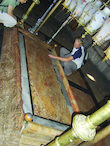Block Scheduling Tips
About this article
Block scheduling means longer class periods for most schools. So what is a high school theology teacher to do in a 70- to 90-minute block of time? This article summarizes block scheduling teaching tips from high school theology teachers across the United States and will start you thinking about the challenges and opportunities of the block.
For a couple of years, Saint Mary's Press sponsored a listserv discussion group online. Discussions on a variety of topics were pursued via e-mail. It is my hope that I can summarize some of the highlights from these old files in our resources section of the web site. Because some people did not identify themselves by name and all I have is an e-mail address, I can not give specific credit to individuals for the ideas listed below. Because this site wishes to promote a spirit of professional sharing, I believe it is appropriate that these ideas be passed along. Please remember that our discussion forum is available for any topics that you would like to ask for feedback on!
Block scheduling certainly seems to have become a "hot" topic the past few years. More and more teachers speak of "the block" at workshops and textbooks are responding to this restructuring of academic time. There are many different types of block scheduling ranging from a "4 by 4" schedule where four classes are taught each semester to a rotating A/B schedule where 4 classes meet on day A and the others meet on day B. There are also schools with a "modified" approach where some days are 7 or 8 periods and the others days are block periods. The common denominator seems to be that instructional periods are of longer lengths, typically between 75-90 minutes. So what does a religion teacher do in a period of that length? What suggestions or strategies seem to be working? I believe there is some "collective wisdom" in the postings that follow which come from the listserv in late 1998 and early 1999! Thanks to all who may recognize his or her comments!
- A key for success is teacher preparation and inservicing. It is also critical to educate parents and students about block scheduling. Consider bringing in speakers, possibly teachers from other schools, to come in and talk about their experiences.
- Start with a bible reading or journal assignment to get students on task while you take roll, check homework, or return papers. Then lecture, do group work, take questions on homework, or take a test or quiz.
- Do at least three things during a block period. Avoid 90-minute lectures!
- Plan films so discussion can follow in the block period.
- The block period means it is easier to schedule prayer experiences with students.
- Build your repertoire of teaching strategies and learning techniques that focus on active learning. Multiple intelligence theory is ideal for implementing within a block schedule.
- Opportunities for service experiences have been expanded in some schools. One mentioned her students leaving campus every other day to give an hour of service.
- Lesson planning needs a major overhaul since there may be a tendency to go deeper and deeper into the content and not get the same breadth. There is a need to have the desired outcomes articulated for each course.
- Student load seems lighter since there are fewer students to meet each day. Consequently, longer periods of time mean more time to get to know the students.
Consider each of these a prompt and let's continue the discussion and sharing of successes and challenges within the block schedule in our discussion forum!
Acknowledgments
Copyright © 2009 Saint Mary's Press. Permission is granted for this article to be freely used for classroom or campus ministry purposes; however, it may not be republished in any form without the explicit permission of Saint Mary's Press. For more resources to support your ministry, call 800-533-8095 or visit our Web site at www.smp.org.Published December 28, 1999.





